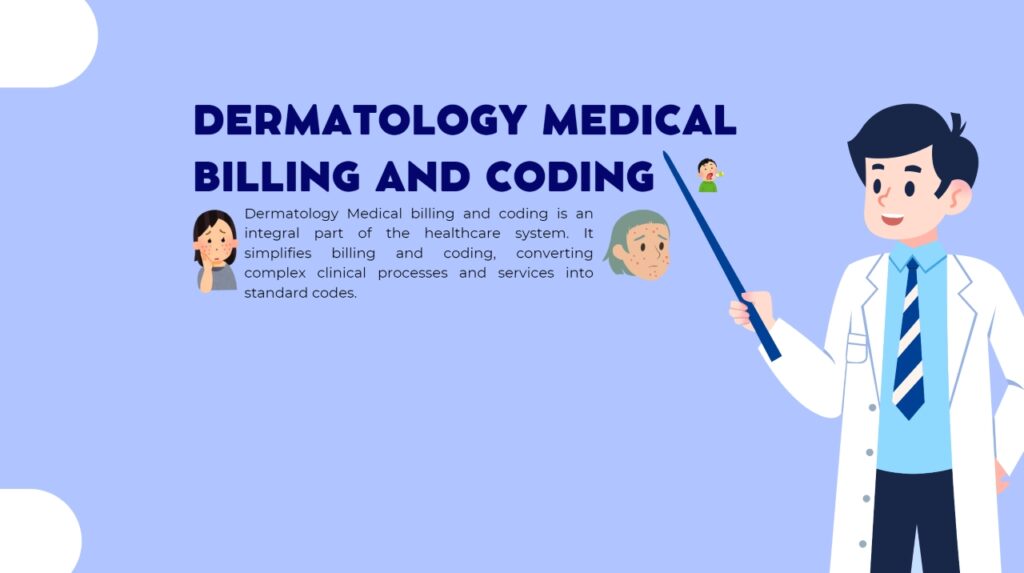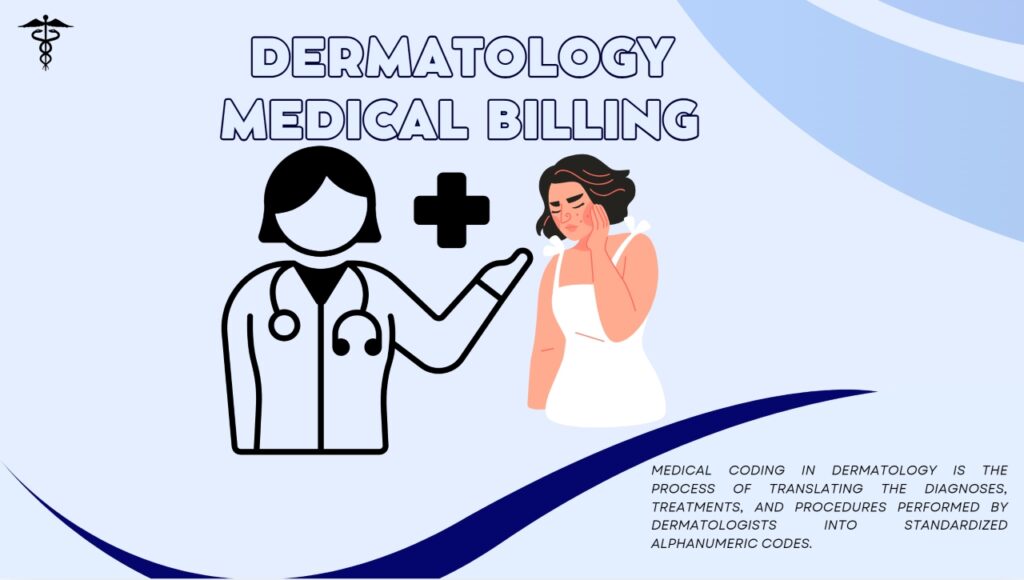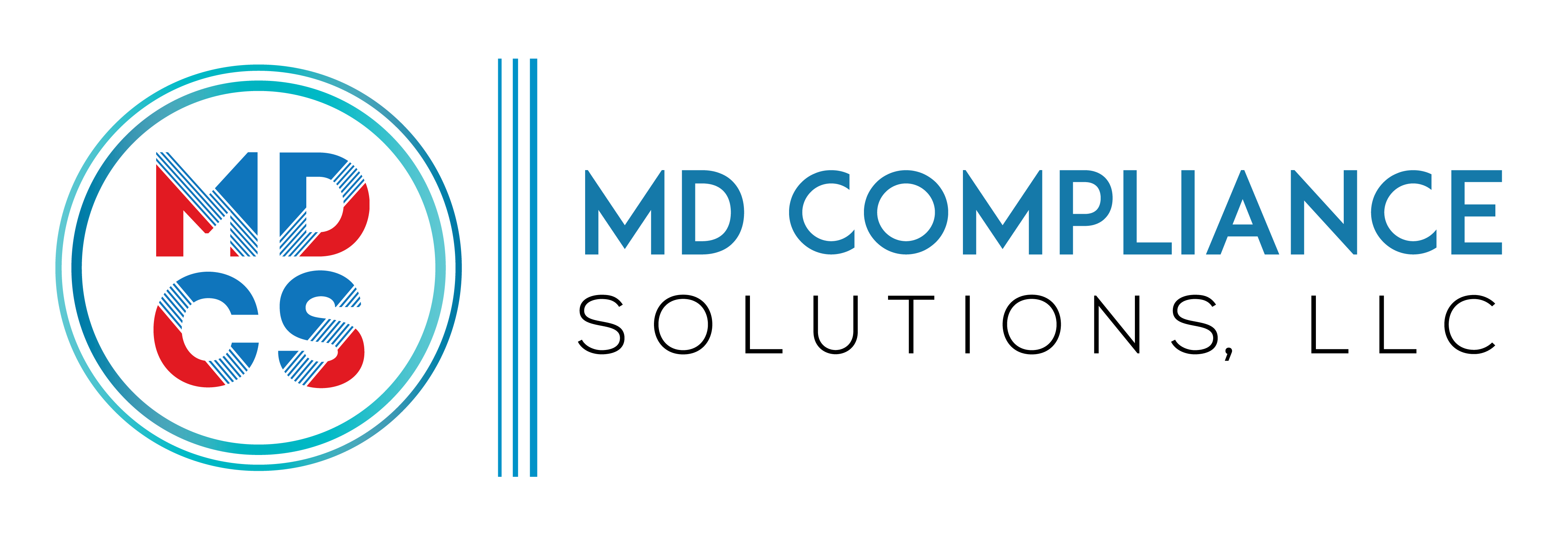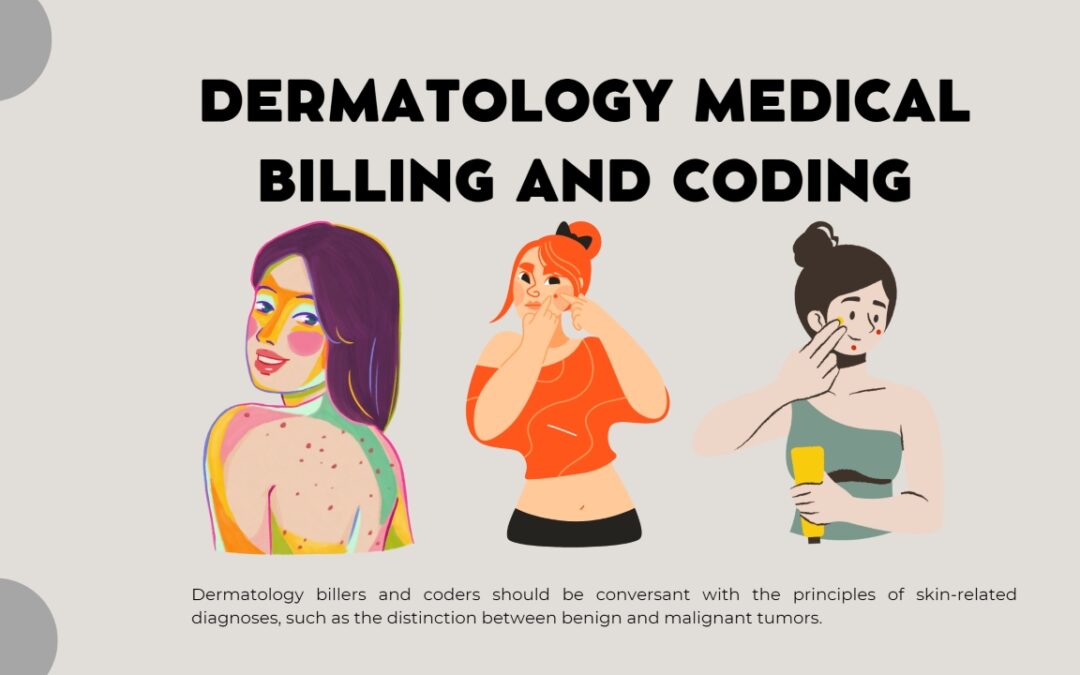Table of Contents
Dermatology Medical billing and coding is an integral part of the healthcare system. It simplifies billing and recording, converting complex clinical processes and services into standard codes. Dermatology billers and coders should be conversant with the principles of skin-related diagnoses, such as the distinction between benign and malignant tumors. In dermatology medical billing, exact coding is critical not only for financial reimbursement but also for maintaining complete patient records.
Let’s Understand Dermatology Medical Billing and Coding
Medical coding in dermatology is the process of translating diagnoses, treatments, and procedures performed by dermatologists into standardized alphanumeric codes. These standardized codes follow global standards and ensure accuracy and consistency across the healthcare system. It is crucial to use these codes to facilitate clear communication between insurance companies and healthcare providers so that medical claims can be processed quickly and paid accurately. Medical coders and billers must understand the distinction between cosmetic and medical dermatology. Remember, some services, such as mole removal, might fall under both categories.
For clinical services, complete patient records protection, standardized documentation, and speedy invoicing all depend on precise code assignment. It also increases administrative effectiveness and ensures compliance with healthcare laws. The dermatology billing data reporting workflow entails tracking and reporting information about services rendered, payments received, and any outstanding claims or denials. Accurate data reporting is critical for evaluating the practice’s financial health and identifying opportunities for enhancement.
Standardized coding establishes a clear connection between dermatology practice’s revenue cycle and procedures and eventually boosts payment to increase the overall accuracy and clarity of the healthcare system. Dermatology Medical Billing and Coding is an essential part of effective healthcare administration, which gives an accurate picture of the services offered. This helps with financial transactions, operational effectiveness, and regulatory compliance. Dermatologists can avoid needless revenue loss by submitting claims on time.

Basic Coding in Dermatology
CPT Code: 17000-17004 (Cryotherapy)
Cryotherapy (CPT codes 17000-17004) is used to treat a variety of skin problems. It employs freezing techniques to treat concerns such as warts or growths that may eventually develop into cancer. The CPT code is assigned based on the number and size (depth, length, width, and circumference) of the lesions treated. Exact dermatology coding includes cryotherapy, which involves freezing and removing undesirable skin cells with extremely cold liquid nitrogen. This coding system ensures correct invoicing and communication between healthcare providers and payers. Understanding these codes allows us to transfer the benefits of cryotherapy into concrete financial initiatives.
CPT Code: 96910-96912 (Phototherapy)
Phototherapy, which employs light to treat a variety of skin disorders, including psoriasis and eczema, is classified under CPT code 96910-96912. These codes are based on a variety of parameters, including the type of phototherapy utilized and where it is administered. This procedure involves carefully regulated contact with light sources, which aids in the healing process. Precise billing is indispensable for efficient communication between healthcare providers and insurers. Accurate labeling facilitates the translation of phototherapy benefits into productive financial operations.
Below are common dermatology-related medical codes, which are important to understand.
Urticaria is classified as L50 in ICD-10; however, it encompasses a number of other diagnosis codes.
L50.0 – Allergic urticaria
L50.1 – Idiopathic urticaria
L50.2 – Urticaria due to cold and heat
L50.3 – Dermatographic urticaria
L50.4 – Vibratory urticaria
L50.5 – Cholinergic urticaria
L50.6 – Contact urticaria
L50.8 – Other urticaria
L50.9 – Urticaria, unspecified
Some ICD-10 codes appear to be linked to urticaria; however, they are actually distinct diseases. Here are a few examples.
L28.2 – Urticaria papulosa
D47.01 – Urticaria pigmentosa
L56.3 – Solar urticaria
T78.3 – Giant urticaria
T80.6 – Serum urticaria
P83.8 – Urticaria neonatorum
Dermatology medical billers can also benefit from knowing the ICD-10 codes for acne.
L70.0 – Acne vulgaris
L70.1 – Acne conglobata
L70.2 – Acne varioliformis
L70.3 – Acne tropica
L70.4 – Infantile acne
L70.5 – Acne excoriée
L70.8 – Other acne
L70.9 – Acne, unspecified
L73.0 – Acne keloid
In the modern era, dermatology medical billing and coding involve a number of interconnected stages:
- There are standardized codes in the spectrum of dermatology procedures, including simple skin examinations to intricate operations. The ICD codes classify diagnoses, and CPT codes are used to bill for medical services. Hence, appropriate diagnosis coding is essential for accurate invoicing.
- Insurance companies submit claims for payment for the rendered services. Before starting the reimbursement procedures, insurance companies check the claims to make sure they are accurate and according to their policies.
Primary Benefits of Dermatology Billing and Coding Services
- Claims are filed and followed up on right away in order to reduce late payments and improve cash flow efficiency.
- In the ever-changing health care industry, the consistent knowledge of coding requirements and modifications ensures professional standards are met, increasing the frequency of claims approval.
- By hiring the service of MD Compliance Solutions for billing and coding, dermatologists may concentrate on patient care and delegate administrative responsibilities to others who handle them.
Coding Hints for Precision
- Accurate coding requires precise information, i.e., place, size, and the specific skin conditions being treated. Complete documentation is critical for ensuring that everything is coded correctly.
- Prior to performing any treatments, dermatology billing personnel must obtain pre-authorization from the patient’s insurance carrier. Accurate verification reduces the possibility that claims will be rejected and facilitates speedy insurance payer reimbursement.
- Modifiers are indispensable for delivering additional information to payers. It is critical to note that modifier -59 specifies a different procedural service, which clarifies billing disparities and improves coding precision.
- Dermatology billers may find it particularly difficult to capture charges because their doctors frequently execute the same procedure on multiple anatomic regions during a single visit. The relationships between the skin on various body parts and various organ systems and subspecialties can alter the requirements for billing and coding.
- Dermatology medical billing and coding are frequently changing. To uphold the correctness of your coding job, you should remain compliant, adapt to changes in coding standards, and seek out the latest information on a frequent basis.
Challenges
- Dermatology medical billing is prone to upcoding, which means billing for a higher level of care. To be properly compensated for their services, dermatology billers must avoid undercoding.
- Undercoding occurs when a dermatologist employs cryotherapy to eliminate a cancerous tumor but invoices for a less difficult procedure, such as a simple excision. Similarly, clinicians may perform electrosurgery to kill a growth while billing for a simpler therapy such as electrodesiccation.
- Medical billers process hundreds of claims per day, with staff spending hours of manually entering data and following up with patients to collect payments. This might lead to revenue creep and increasing expenditures for the practice owing to human error. Completing a significant volume of documentation by hand results in incorrect code assignments, which lead to claim denials.
- In order to avoid human errors, the latest medical billing software provides the best solutions to incorporate features such as automated medical coding, electronic claims filing, automatic patient eligibility verification, and connectivity with EHR and electronic medical record (EMR) systems to improve workflows and reduce errors.
Wrap Up:
Dermatology Medical coding is a critical component for practice and payment and facilitates communication between healthcare practitioners and insurance companies. Basic coding abilities are required for accurate and timely medical coding in dermatology. This coding serves as a link between healthcare treatments and financial considerations. It guarantees that everything is understandable and right. Read More: What is Coordination of Benefits (COB)?


